Financial Strategies and Analysis for Volkswagen Expansion Project
VerifiedAdded on 2020/01/23
|17
|4502
|64
Report
AI Summary
This report provides a comprehensive financial analysis of Volkswagen, focusing on the company's strategies for expansion and investment. It begins by exploring both internal and external sources of finance, such as equity issues, debt financing, and retained earnings, evaluating their implications and associated costs. The report then assesses the suitability of different financing options for Volkswagen, recommending a combination of equity finance and bank overdrafts. It delves into the importance of financial planning and the information needs of various decision-makers, including management, shareholders, and financial institutions. The report further examines the impact of finance on financial statements, including the income statement, position statement, and cash flow statement. It then analyzes budgets to make viable business decisions, including unit cost calculations and pricing strategies, with examples of markups and return on capital employed. Investment appraisal techniques, such as NPV and ARR, are used to assess project viability, and the report concludes with a comparison of financial statement formats and the interpretation of financial statements through ratio analysis, using Volkswagen's financial data as a case study.

MFRD
Paraphrase This Document
Need a fresh take? Get an instant paraphrase of this document with our AI Paraphraser
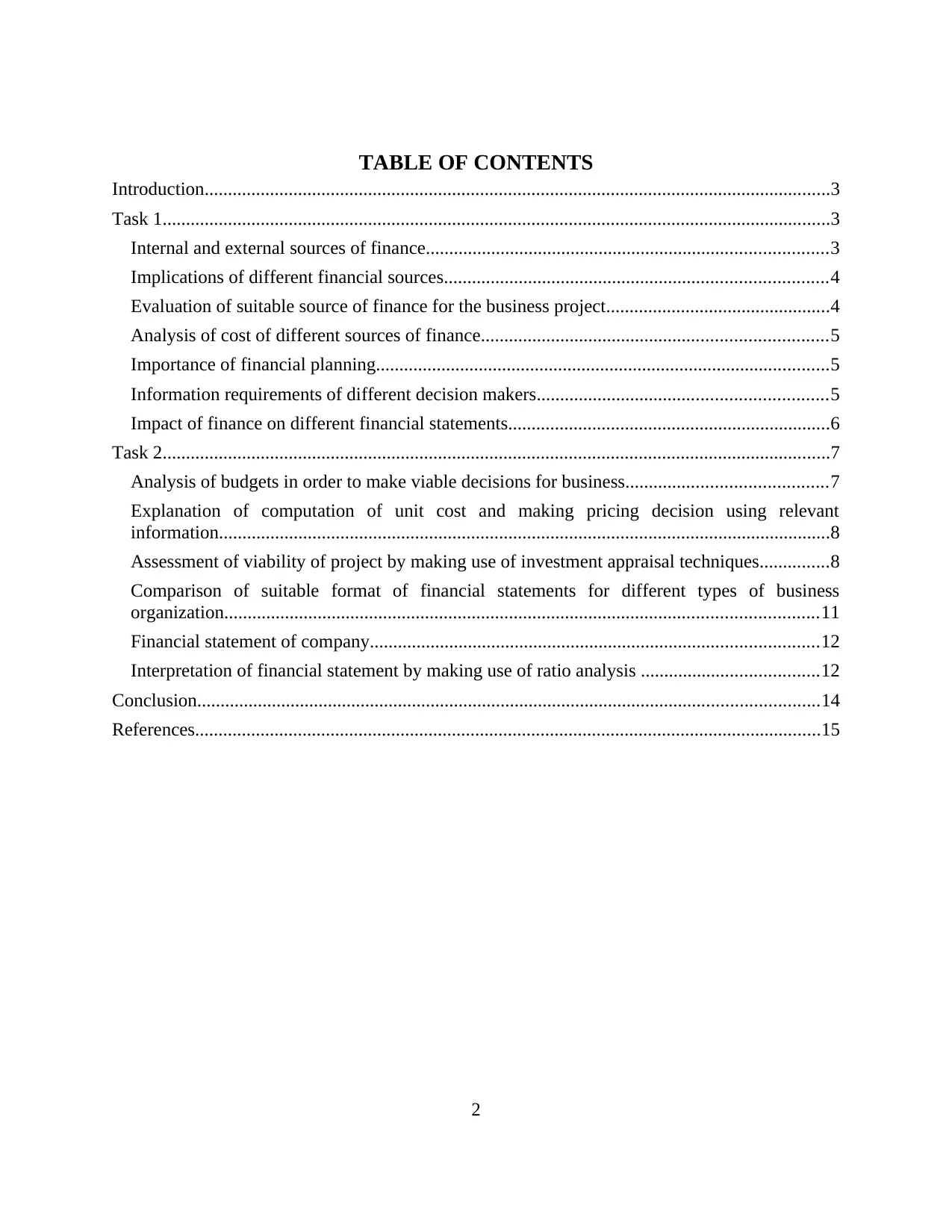
TABLE OF CONTENTS
Introduction......................................................................................................................................3
Task 1...............................................................................................................................................3
Internal and external sources of finance......................................................................................3
Implications of different financial sources..................................................................................4
Evaluation of suitable source of finance for the business project................................................4
Analysis of cost of different sources of finance..........................................................................5
Importance of financial planning.................................................................................................5
Information requirements of different decision makers..............................................................5
Impact of finance on different financial statements.....................................................................6
Task 2...............................................................................................................................................7
Analysis of budgets in order to make viable decisions for business...........................................7
Explanation of computation of unit cost and making pricing decision using relevant
information...................................................................................................................................8
Assessment of viability of project by making use of investment appraisal techniques...............8
Comparison of suitable format of financial statements for different types of business
organization...............................................................................................................................11
Financial statement of company................................................................................................12
Interpretation of financial statement by making use of ratio analysis ......................................12
Conclusion.....................................................................................................................................14
References......................................................................................................................................15
2
Introduction......................................................................................................................................3
Task 1...............................................................................................................................................3
Internal and external sources of finance......................................................................................3
Implications of different financial sources..................................................................................4
Evaluation of suitable source of finance for the business project................................................4
Analysis of cost of different sources of finance..........................................................................5
Importance of financial planning.................................................................................................5
Information requirements of different decision makers..............................................................5
Impact of finance on different financial statements.....................................................................6
Task 2...............................................................................................................................................7
Analysis of budgets in order to make viable decisions for business...........................................7
Explanation of computation of unit cost and making pricing decision using relevant
information...................................................................................................................................8
Assessment of viability of project by making use of investment appraisal techniques...............8
Comparison of suitable format of financial statements for different types of business
organization...............................................................................................................................11
Financial statement of company................................................................................................12
Interpretation of financial statement by making use of ratio analysis ......................................12
Conclusion.....................................................................................................................................14
References......................................................................................................................................15
2
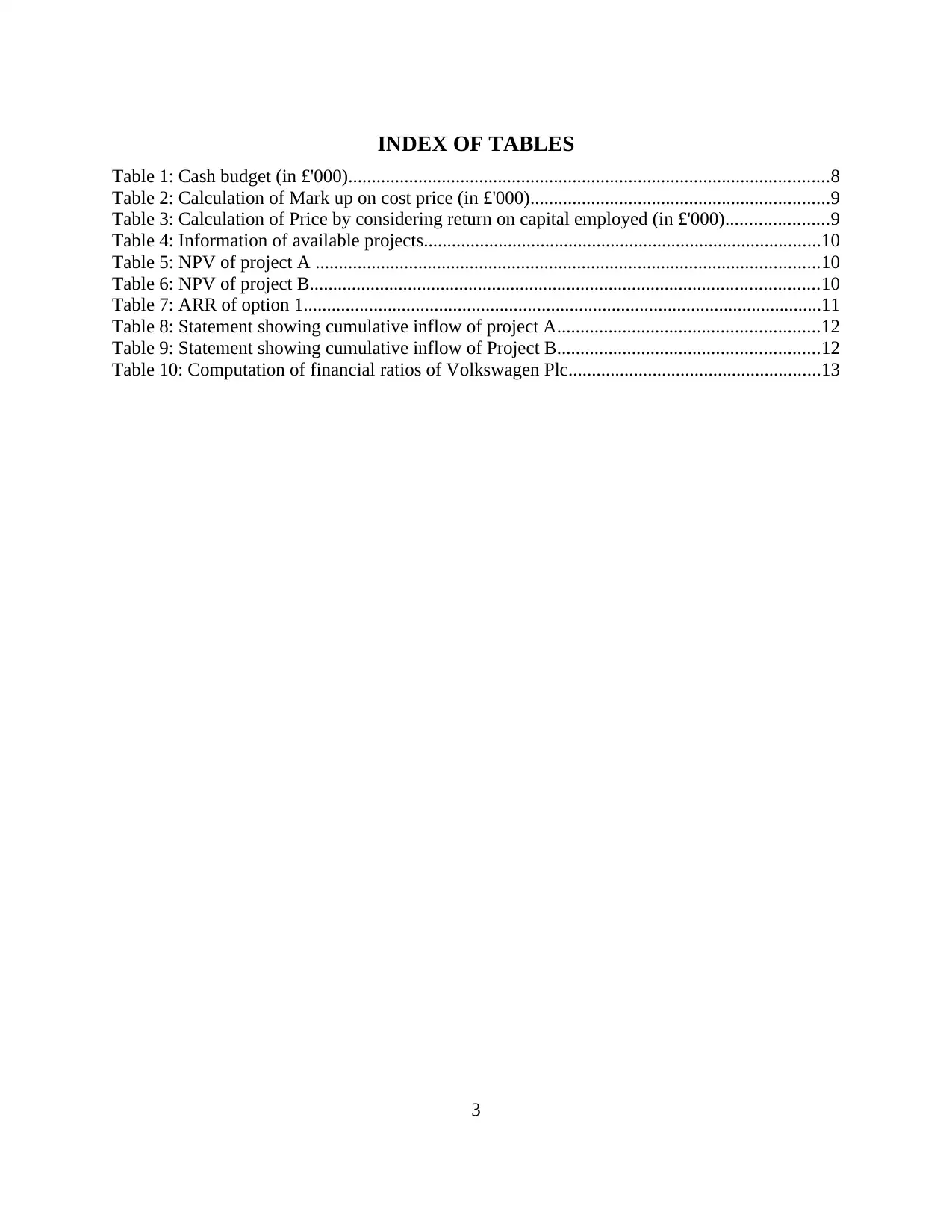
INDEX OF TABLES
Table 1: Cash budget (in £'000).......................................................................................................8
Table 2: Calculation of Mark up on cost price (in £'000)................................................................9
Table 3: Calculation of Price by considering return on capital employed (in £'000)......................9
Table 4: Information of available projects.....................................................................................10
Table 5: NPV of project A ............................................................................................................10
Table 6: NPV of project B.............................................................................................................10
Table 7: ARR of option 1...............................................................................................................11
Table 8: Statement showing cumulative inflow of project A........................................................12
Table 9: Statement showing cumulative inflow of Project B........................................................12
Table 10: Computation of financial ratios of Volkswagen Plc......................................................13
3
Table 1: Cash budget (in £'000).......................................................................................................8
Table 2: Calculation of Mark up on cost price (in £'000)................................................................9
Table 3: Calculation of Price by considering return on capital employed (in £'000)......................9
Table 4: Information of available projects.....................................................................................10
Table 5: NPV of project A ............................................................................................................10
Table 6: NPV of project B.............................................................................................................10
Table 7: ARR of option 1...............................................................................................................11
Table 8: Statement showing cumulative inflow of project A........................................................12
Table 9: Statement showing cumulative inflow of Project B........................................................12
Table 10: Computation of financial ratios of Volkswagen Plc......................................................13
3
⊘ This is a preview!⊘
Do you want full access?
Subscribe today to unlock all pages.

Trusted by 1+ million students worldwide
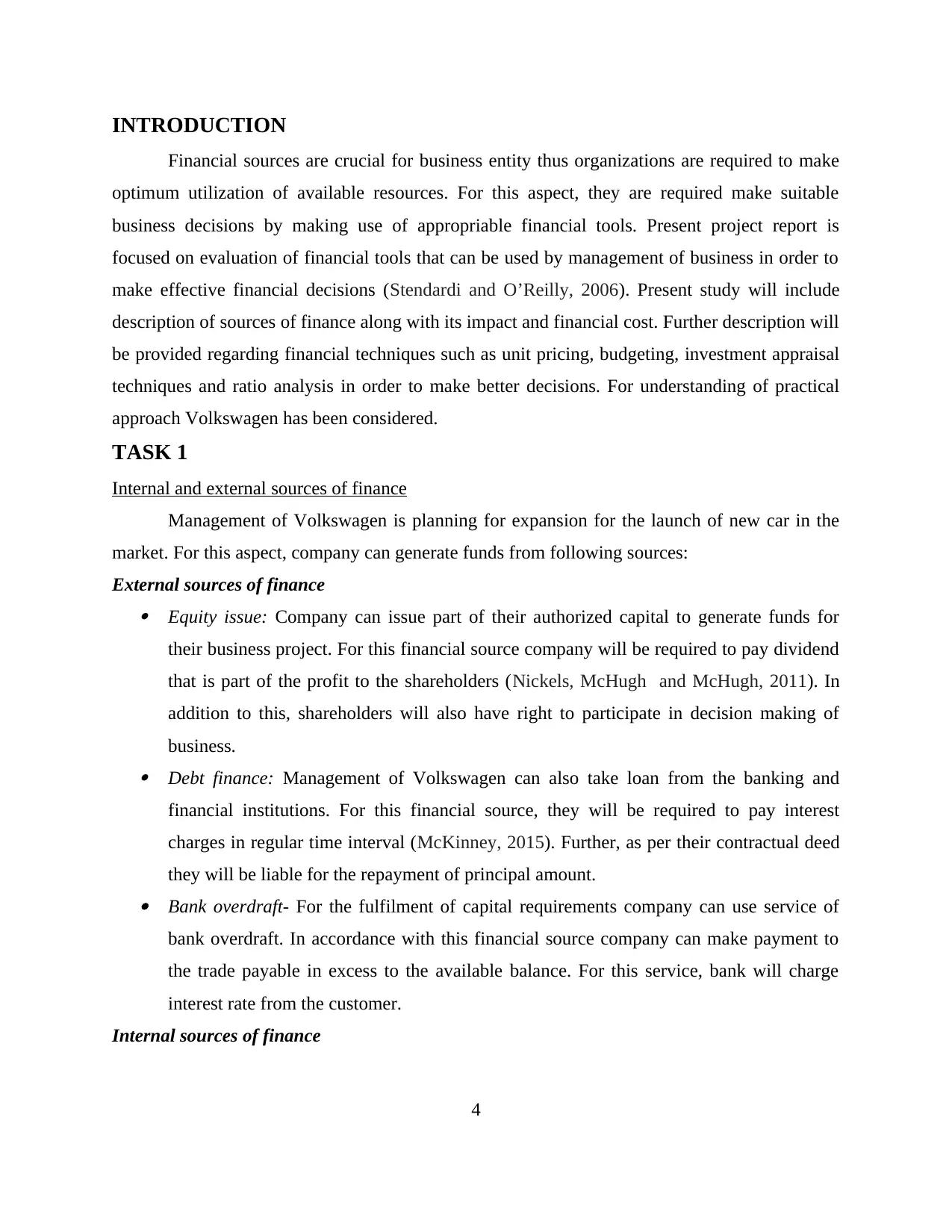
INTRODUCTION
Financial sources are crucial for business entity thus organizations are required to make
optimum utilization of available resources. For this aspect, they are required make suitable
business decisions by making use of appropriable financial tools. Present project report is
focused on evaluation of financial tools that can be used by management of business in order to
make effective financial decisions (Stendardi and O’Reilly, 2006). Present study will include
description of sources of finance along with its impact and financial cost. Further description will
be provided regarding financial techniques such as unit pricing, budgeting, investment appraisal
techniques and ratio analysis in order to make better decisions. For understanding of practical
approach Volkswagen has been considered.
TASK 1
Internal and external sources of finance
Management of Volkswagen is planning for expansion for the launch of new car in the
market. For this aspect, company can generate funds from following sources:
External sources of finance Equity issue: Company can issue part of their authorized capital to generate funds for
their business project. For this financial source company will be required to pay dividend
that is part of the profit to the shareholders (Nickels, McHugh and McHugh, 2011). In
addition to this, shareholders will also have right to participate in decision making of
business. Debt finance: Management of Volkswagen can also take loan from the banking and
financial institutions. For this financial source, they will be required to pay interest
charges in regular time interval (McKinney, 2015). Further, as per their contractual deed
they will be liable for the repayment of principal amount. Bank overdraft- For the fulfilment of capital requirements company can use service of
bank overdraft. In accordance with this financial source company can make payment to
the trade payable in excess to the available balance. For this service, bank will charge
interest rate from the customer.
Internal sources of finance
4
Financial sources are crucial for business entity thus organizations are required to make
optimum utilization of available resources. For this aspect, they are required make suitable
business decisions by making use of appropriable financial tools. Present project report is
focused on evaluation of financial tools that can be used by management of business in order to
make effective financial decisions (Stendardi and O’Reilly, 2006). Present study will include
description of sources of finance along with its impact and financial cost. Further description will
be provided regarding financial techniques such as unit pricing, budgeting, investment appraisal
techniques and ratio analysis in order to make better decisions. For understanding of practical
approach Volkswagen has been considered.
TASK 1
Internal and external sources of finance
Management of Volkswagen is planning for expansion for the launch of new car in the
market. For this aspect, company can generate funds from following sources:
External sources of finance Equity issue: Company can issue part of their authorized capital to generate funds for
their business project. For this financial source company will be required to pay dividend
that is part of the profit to the shareholders (Nickels, McHugh and McHugh, 2011). In
addition to this, shareholders will also have right to participate in decision making of
business. Debt finance: Management of Volkswagen can also take loan from the banking and
financial institutions. For this financial source, they will be required to pay interest
charges in regular time interval (McKinney, 2015). Further, as per their contractual deed
they will be liable for the repayment of principal amount. Bank overdraft- For the fulfilment of capital requirements company can use service of
bank overdraft. In accordance with this financial source company can make payment to
the trade payable in excess to the available balance. For this service, bank will charge
interest rate from the customer.
Internal sources of finance
4
Paraphrase This Document
Need a fresh take? Get an instant paraphrase of this document with our AI Paraphraser
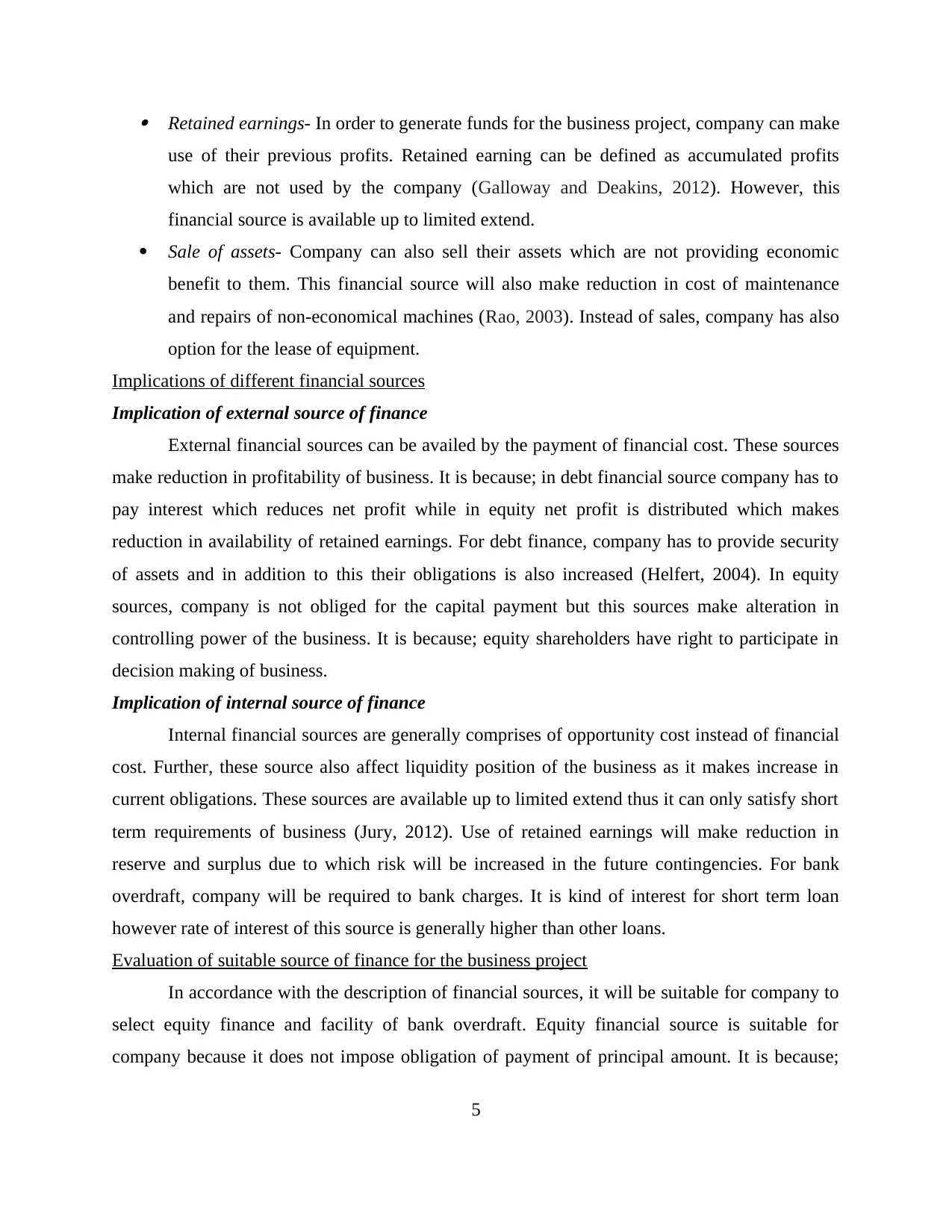
Retained earnings- In order to generate funds for the business project, company can make
use of their previous profits. Retained earning can be defined as accumulated profits
which are not used by the company (Galloway and Deakins, 2012). However, this
financial source is available up to limited extend.
Sale of assets- Company can also sell their assets which are not providing economic
benefit to them. This financial source will also make reduction in cost of maintenance
and repairs of non-economical machines (Rao, 2003). Instead of sales, company has also
option for the lease of equipment.
Implications of different financial sources
Implication of external source of finance
External financial sources can be availed by the payment of financial cost. These sources
make reduction in profitability of business. It is because; in debt financial source company has to
pay interest which reduces net profit while in equity net profit is distributed which makes
reduction in availability of retained earnings. For debt finance, company has to provide security
of assets and in addition to this their obligations is also increased (Helfert, 2004). In equity
sources, company is not obliged for the capital payment but this sources make alteration in
controlling power of the business. It is because; equity shareholders have right to participate in
decision making of business.
Implication of internal source of finance
Internal financial sources are generally comprises of opportunity cost instead of financial
cost. Further, these source also affect liquidity position of the business as it makes increase in
current obligations. These sources are available up to limited extend thus it can only satisfy short
term requirements of business (Jury, 2012). Use of retained earnings will make reduction in
reserve and surplus due to which risk will be increased in the future contingencies. For bank
overdraft, company will be required to bank charges. It is kind of interest for short term loan
however rate of interest of this source is generally higher than other loans.
Evaluation of suitable source of finance for the business project
In accordance with the description of financial sources, it will be suitable for company to
select equity finance and facility of bank overdraft. Equity financial source is suitable for
company because it does not impose obligation of payment of principal amount. It is because;
5
use of their previous profits. Retained earning can be defined as accumulated profits
which are not used by the company (Galloway and Deakins, 2012). However, this
financial source is available up to limited extend.
Sale of assets- Company can also sell their assets which are not providing economic
benefit to them. This financial source will also make reduction in cost of maintenance
and repairs of non-economical machines (Rao, 2003). Instead of sales, company has also
option for the lease of equipment.
Implications of different financial sources
Implication of external source of finance
External financial sources can be availed by the payment of financial cost. These sources
make reduction in profitability of business. It is because; in debt financial source company has to
pay interest which reduces net profit while in equity net profit is distributed which makes
reduction in availability of retained earnings. For debt finance, company has to provide security
of assets and in addition to this their obligations is also increased (Helfert, 2004). In equity
sources, company is not obliged for the capital payment but this sources make alteration in
controlling power of the business. It is because; equity shareholders have right to participate in
decision making of business.
Implication of internal source of finance
Internal financial sources are generally comprises of opportunity cost instead of financial
cost. Further, these source also affect liquidity position of the business as it makes increase in
current obligations. These sources are available up to limited extend thus it can only satisfy short
term requirements of business (Jury, 2012). Use of retained earnings will make reduction in
reserve and surplus due to which risk will be increased in the future contingencies. For bank
overdraft, company will be required to bank charges. It is kind of interest for short term loan
however rate of interest of this source is generally higher than other loans.
Evaluation of suitable source of finance for the business project
In accordance with the description of financial sources, it will be suitable for company to
select equity finance and facility of bank overdraft. Equity financial source is suitable for
company because it does not impose obligation of payment of principal amount. It is because;
5
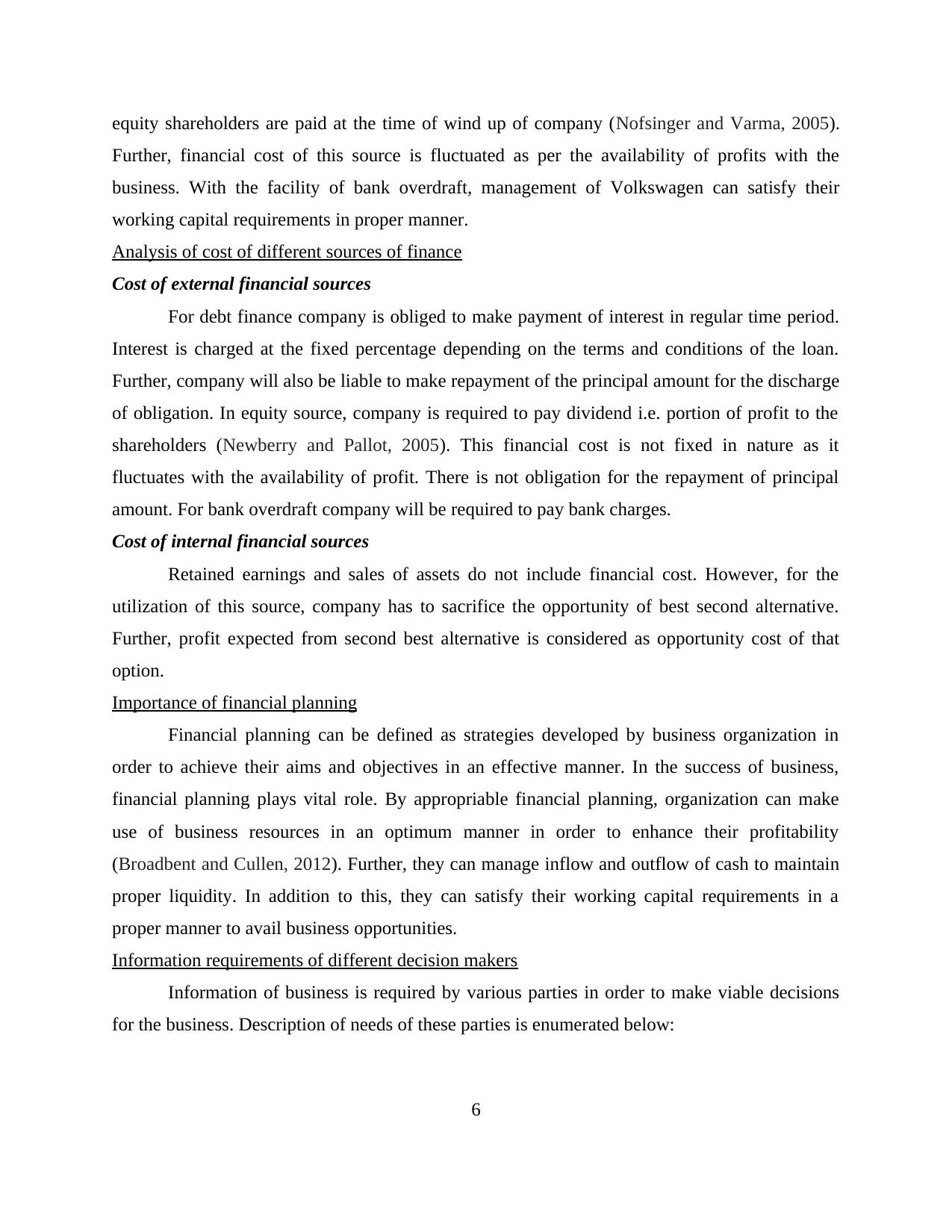
equity shareholders are paid at the time of wind up of company (Nofsinger and Varma, 2005).
Further, financial cost of this source is fluctuated as per the availability of profits with the
business. With the facility of bank overdraft, management of Volkswagen can satisfy their
working capital requirements in proper manner.
Analysis of cost of different sources of finance
Cost of external financial sources
For debt finance company is obliged to make payment of interest in regular time period.
Interest is charged at the fixed percentage depending on the terms and conditions of the loan.
Further, company will also be liable to make repayment of the principal amount for the discharge
of obligation. In equity source, company is required to pay dividend i.e. portion of profit to the
shareholders (Newberry and Pallot, 2005). This financial cost is not fixed in nature as it
fluctuates with the availability of profit. There is not obligation for the repayment of principal
amount. For bank overdraft company will be required to pay bank charges.
Cost of internal financial sources
Retained earnings and sales of assets do not include financial cost. However, for the
utilization of this source, company has to sacrifice the opportunity of best second alternative.
Further, profit expected from second best alternative is considered as opportunity cost of that
option.
Importance of financial planning
Financial planning can be defined as strategies developed by business organization in
order to achieve their aims and objectives in an effective manner. In the success of business,
financial planning plays vital role. By appropriable financial planning, organization can make
use of business resources in an optimum manner in order to enhance their profitability
(Broadbent and Cullen, 2012). Further, they can manage inflow and outflow of cash to maintain
proper liquidity. In addition to this, they can satisfy their working capital requirements in a
proper manner to avail business opportunities.
Information requirements of different decision makers
Information of business is required by various parties in order to make viable decisions
for the business. Description of needs of these parties is enumerated below:
6
Further, financial cost of this source is fluctuated as per the availability of profits with the
business. With the facility of bank overdraft, management of Volkswagen can satisfy their
working capital requirements in proper manner.
Analysis of cost of different sources of finance
Cost of external financial sources
For debt finance company is obliged to make payment of interest in regular time period.
Interest is charged at the fixed percentage depending on the terms and conditions of the loan.
Further, company will also be liable to make repayment of the principal amount for the discharge
of obligation. In equity source, company is required to pay dividend i.e. portion of profit to the
shareholders (Newberry and Pallot, 2005). This financial cost is not fixed in nature as it
fluctuates with the availability of profit. There is not obligation for the repayment of principal
amount. For bank overdraft company will be required to pay bank charges.
Cost of internal financial sources
Retained earnings and sales of assets do not include financial cost. However, for the
utilization of this source, company has to sacrifice the opportunity of best second alternative.
Further, profit expected from second best alternative is considered as opportunity cost of that
option.
Importance of financial planning
Financial planning can be defined as strategies developed by business organization in
order to achieve their aims and objectives in an effective manner. In the success of business,
financial planning plays vital role. By appropriable financial planning, organization can make
use of business resources in an optimum manner in order to enhance their profitability
(Broadbent and Cullen, 2012). Further, they can manage inflow and outflow of cash to maintain
proper liquidity. In addition to this, they can satisfy their working capital requirements in a
proper manner to avail business opportunities.
Information requirements of different decision makers
Information of business is required by various parties in order to make viable decisions
for the business. Description of needs of these parties is enumerated below:
6
⊘ This is a preview!⊘
Do you want full access?
Subscribe today to unlock all pages.

Trusted by 1+ million students worldwide
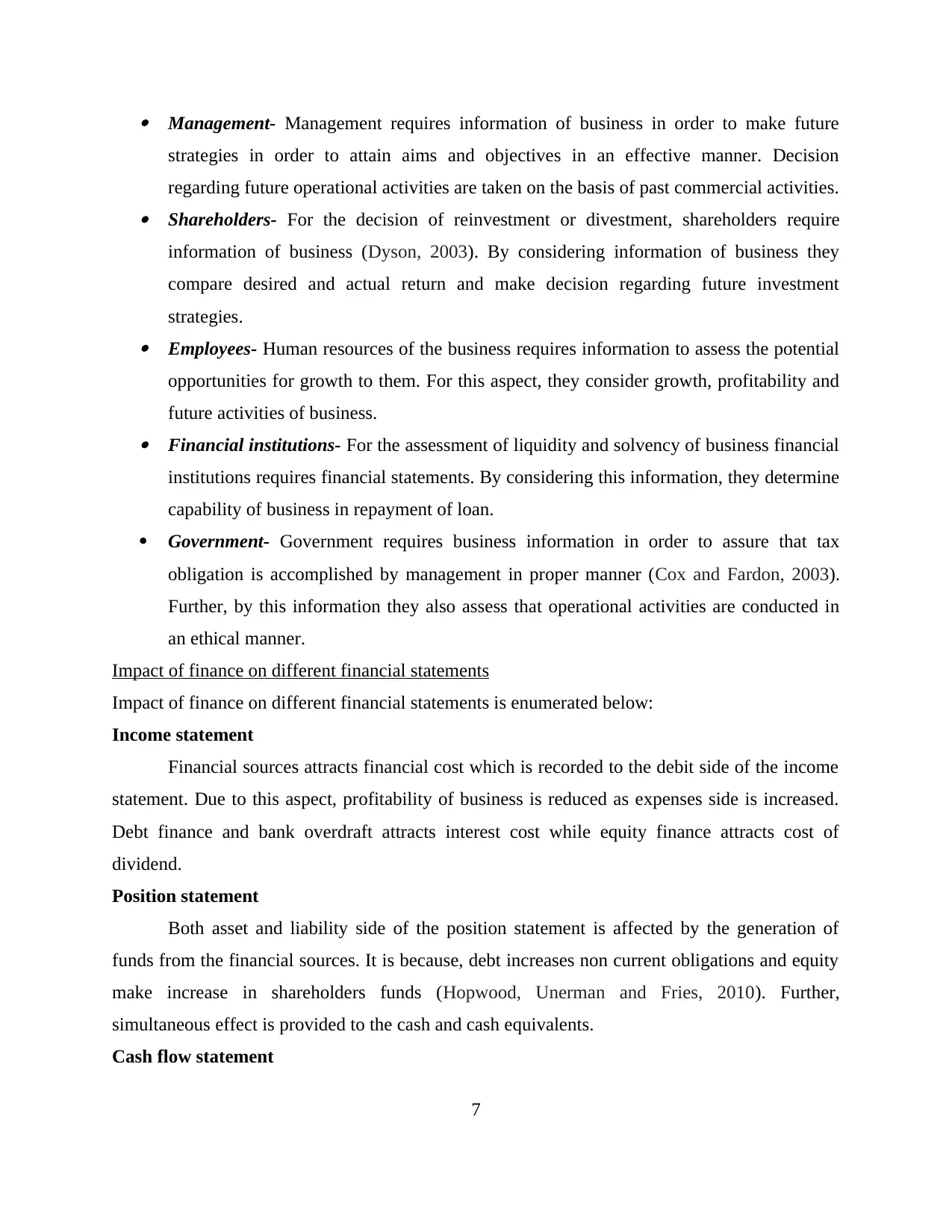
Management- Management requires information of business in order to make future
strategies in order to attain aims and objectives in an effective manner. Decision
regarding future operational activities are taken on the basis of past commercial activities. Shareholders- For the decision of reinvestment or divestment, shareholders require
information of business (Dyson, 2003). By considering information of business they
compare desired and actual return and make decision regarding future investment
strategies. Employees- Human resources of the business requires information to assess the potential
opportunities for growth to them. For this aspect, they consider growth, profitability and
future activities of business. Financial institutions- For the assessment of liquidity and solvency of business financial
institutions requires financial statements. By considering this information, they determine
capability of business in repayment of loan.
Government- Government requires business information in order to assure that tax
obligation is accomplished by management in proper manner (Cox and Fardon, 2003).
Further, by this information they also assess that operational activities are conducted in
an ethical manner.
Impact of finance on different financial statements
Impact of finance on different financial statements is enumerated below:
Income statement
Financial sources attracts financial cost which is recorded to the debit side of the income
statement. Due to this aspect, profitability of business is reduced as expenses side is increased.
Debt finance and bank overdraft attracts interest cost while equity finance attracts cost of
dividend.
Position statement
Both asset and liability side of the position statement is affected by the generation of
funds from the financial sources. It is because, debt increases non current obligations and equity
make increase in shareholders funds (Hopwood, Unerman and Fries, 2010). Further,
simultaneous effect is provided to the cash and cash equivalents.
Cash flow statement
7
strategies in order to attain aims and objectives in an effective manner. Decision
regarding future operational activities are taken on the basis of past commercial activities. Shareholders- For the decision of reinvestment or divestment, shareholders require
information of business (Dyson, 2003). By considering information of business they
compare desired and actual return and make decision regarding future investment
strategies. Employees- Human resources of the business requires information to assess the potential
opportunities for growth to them. For this aspect, they consider growth, profitability and
future activities of business. Financial institutions- For the assessment of liquidity and solvency of business financial
institutions requires financial statements. By considering this information, they determine
capability of business in repayment of loan.
Government- Government requires business information in order to assure that tax
obligation is accomplished by management in proper manner (Cox and Fardon, 2003).
Further, by this information they also assess that operational activities are conducted in
an ethical manner.
Impact of finance on different financial statements
Impact of finance on different financial statements is enumerated below:
Income statement
Financial sources attracts financial cost which is recorded to the debit side of the income
statement. Due to this aspect, profitability of business is reduced as expenses side is increased.
Debt finance and bank overdraft attracts interest cost while equity finance attracts cost of
dividend.
Position statement
Both asset and liability side of the position statement is affected by the generation of
funds from the financial sources. It is because, debt increases non current obligations and equity
make increase in shareholders funds (Hopwood, Unerman and Fries, 2010). Further,
simultaneous effect is provided to the cash and cash equivalents.
Cash flow statement
7
Paraphrase This Document
Need a fresh take? Get an instant paraphrase of this document with our AI Paraphraser
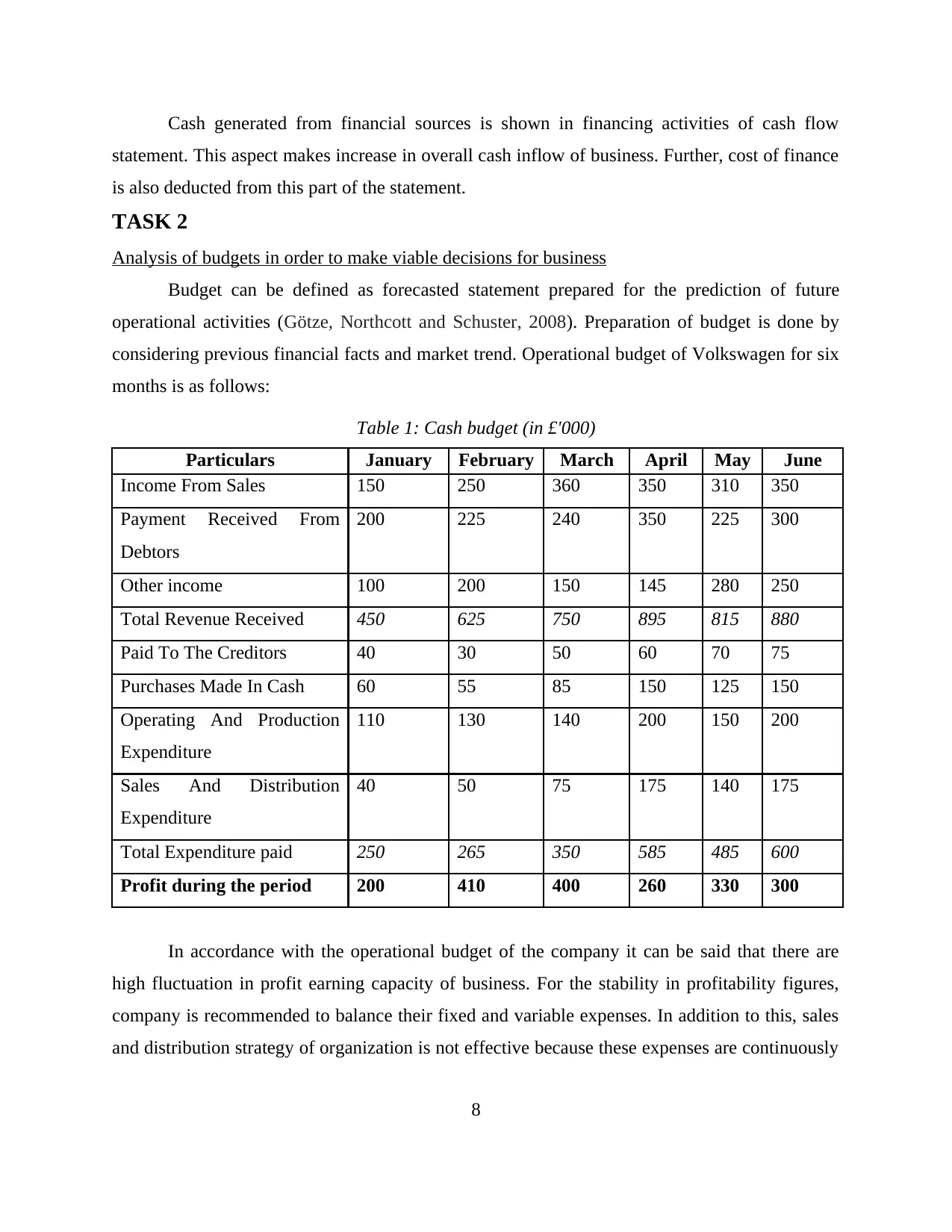
Cash generated from financial sources is shown in financing activities of cash flow
statement. This aspect makes increase in overall cash inflow of business. Further, cost of finance
is also deducted from this part of the statement.
TASK 2
Analysis of budgets in order to make viable decisions for business
Budget can be defined as forecasted statement prepared for the prediction of future
operational activities (Götze, Northcott and Schuster, 2008). Preparation of budget is done by
considering previous financial facts and market trend. Operational budget of Volkswagen for six
months is as follows:
Table 1: Cash budget (in £'000)
Particulars January February March April May June
Income From Sales 150 250 360 350 310 350
Payment Received From
Debtors
200 225 240 350 225 300
Other income 100 200 150 145 280 250
Total Revenue Received 450 625 750 895 815 880
Paid To The Creditors 40 30 50 60 70 75
Purchases Made In Cash 60 55 85 150 125 150
Operating And Production
Expenditure
110 130 140 200 150 200
Sales And Distribution
Expenditure
40 50 75 175 140 175
Total Expenditure paid 250 265 350 585 485 600
Profit during the period 200 410 400 260 330 300
In accordance with the operational budget of the company it can be said that there are
high fluctuation in profit earning capacity of business. For the stability in profitability figures,
company is recommended to balance their fixed and variable expenses. In addition to this, sales
and distribution strategy of organization is not effective because these expenses are continuously
8
statement. This aspect makes increase in overall cash inflow of business. Further, cost of finance
is also deducted from this part of the statement.
TASK 2
Analysis of budgets in order to make viable decisions for business
Budget can be defined as forecasted statement prepared for the prediction of future
operational activities (Götze, Northcott and Schuster, 2008). Preparation of budget is done by
considering previous financial facts and market trend. Operational budget of Volkswagen for six
months is as follows:
Table 1: Cash budget (in £'000)
Particulars January February March April May June
Income From Sales 150 250 360 350 310 350
Payment Received From
Debtors
200 225 240 350 225 300
Other income 100 200 150 145 280 250
Total Revenue Received 450 625 750 895 815 880
Paid To The Creditors 40 30 50 60 70 75
Purchases Made In Cash 60 55 85 150 125 150
Operating And Production
Expenditure
110 130 140 200 150 200
Sales And Distribution
Expenditure
40 50 75 175 140 175
Total Expenditure paid 250 265 350 585 485 600
Profit during the period 200 410 400 260 330 300
In accordance with the operational budget of the company it can be said that there are
high fluctuation in profit earning capacity of business. For the stability in profitability figures,
company is recommended to balance their fixed and variable expenses. In addition to this, sales
and distribution strategy of organization is not effective because these expenses are continuously
8
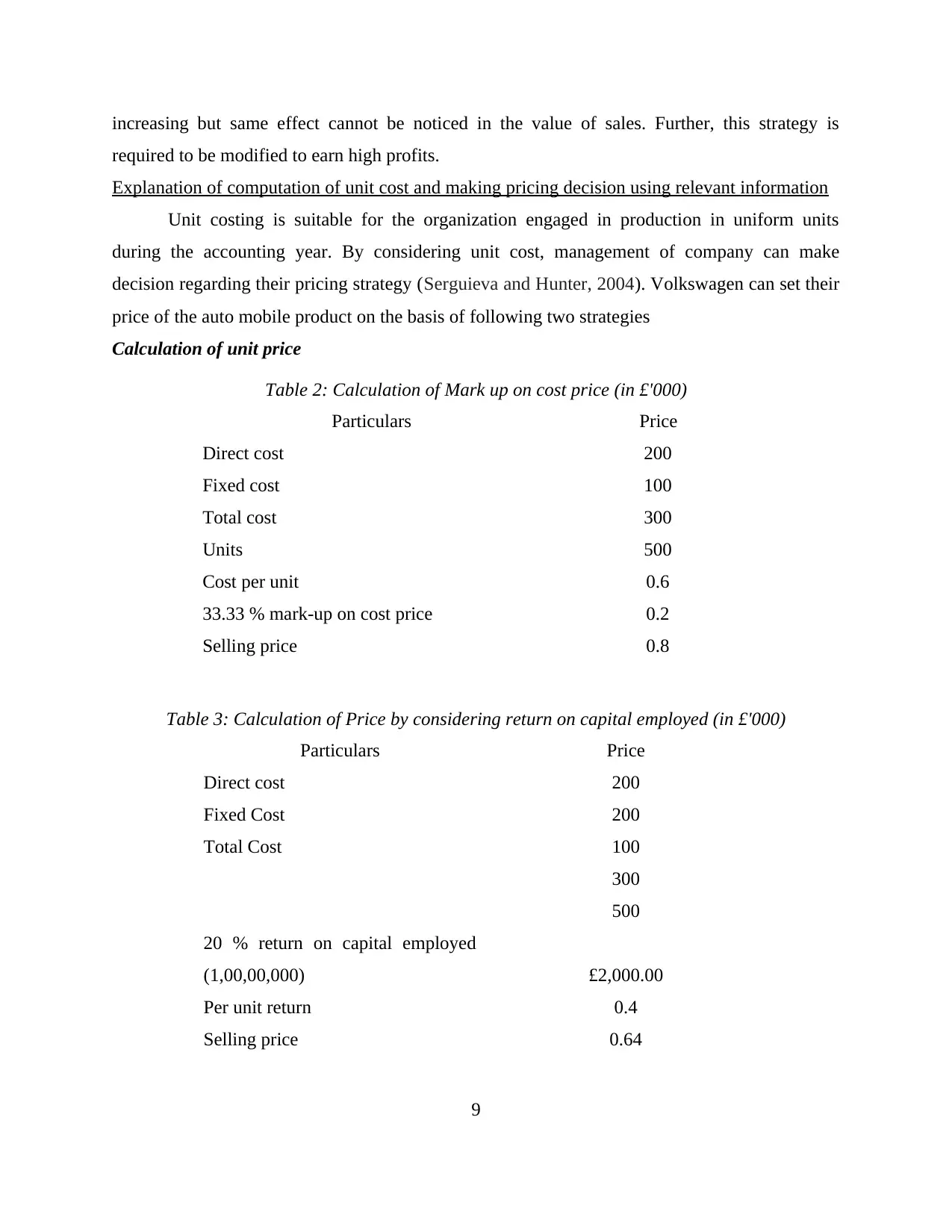
increasing but same effect cannot be noticed in the value of sales. Further, this strategy is
required to be modified to earn high profits.
Explanation of computation of unit cost and making pricing decision using relevant information
Unit costing is suitable for the organization engaged in production in uniform units
during the accounting year. By considering unit cost, management of company can make
decision regarding their pricing strategy (Serguieva and Hunter, 2004). Volkswagen can set their
price of the auto mobile product on the basis of following two strategies
Calculation of unit price
Table 2: Calculation of Mark up on cost price (in £'000)
Particulars Price
Direct cost 200
Fixed cost 100
Total cost 300
Units 500
Cost per unit 0.6
33.33 % mark-up on cost price 0.2
Selling price 0.8
Table 3: Calculation of Price by considering return on capital employed (in £'000)
Particulars Price
Direct cost 200
Fixed Cost 200
Total Cost 100
300
500
20 % return on capital employed
(1,00,00,000) £2,000.00
Per unit return 0.4
Selling price 0.64
9
required to be modified to earn high profits.
Explanation of computation of unit cost and making pricing decision using relevant information
Unit costing is suitable for the organization engaged in production in uniform units
during the accounting year. By considering unit cost, management of company can make
decision regarding their pricing strategy (Serguieva and Hunter, 2004). Volkswagen can set their
price of the auto mobile product on the basis of following two strategies
Calculation of unit price
Table 2: Calculation of Mark up on cost price (in £'000)
Particulars Price
Direct cost 200
Fixed cost 100
Total cost 300
Units 500
Cost per unit 0.6
33.33 % mark-up on cost price 0.2
Selling price 0.8
Table 3: Calculation of Price by considering return on capital employed (in £'000)
Particulars Price
Direct cost 200
Fixed Cost 200
Total Cost 100
300
500
20 % return on capital employed
(1,00,00,000) £2,000.00
Per unit return 0.4
Selling price 0.64
9
⊘ This is a preview!⊘
Do you want full access?
Subscribe today to unlock all pages.

Trusted by 1+ million students worldwide
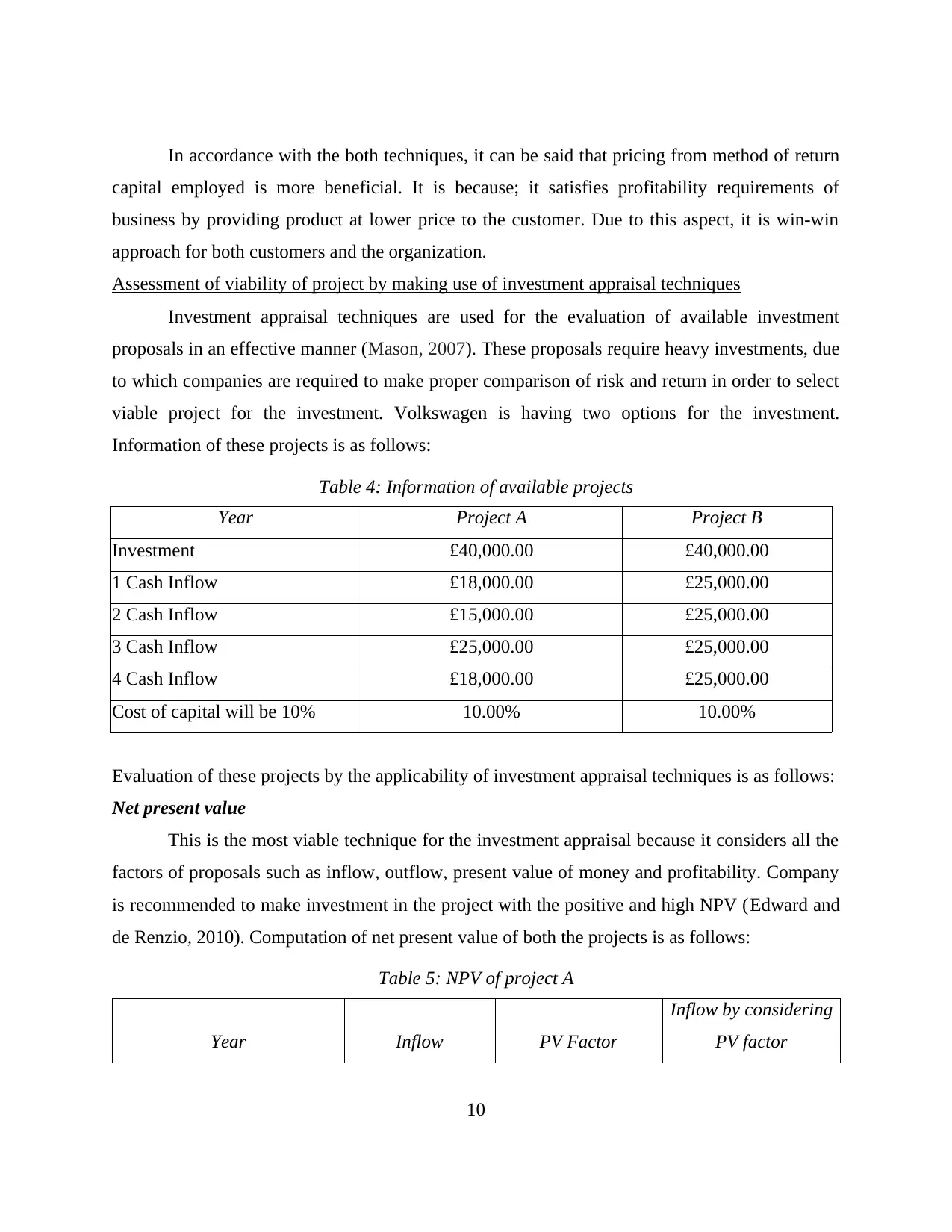
In accordance with the both techniques, it can be said that pricing from method of return
capital employed is more beneficial. It is because; it satisfies profitability requirements of
business by providing product at lower price to the customer. Due to this aspect, it is win-win
approach for both customers and the organization.
Assessment of viability of project by making use of investment appraisal techniques
Investment appraisal techniques are used for the evaluation of available investment
proposals in an effective manner (Mason, 2007). These proposals require heavy investments, due
to which companies are required to make proper comparison of risk and return in order to select
viable project for the investment. Volkswagen is having two options for the investment.
Information of these projects is as follows:
Table 4: Information of available projects
Year Project A Project B
Investment £40,000.00 £40,000.00
1 Cash Inflow £18,000.00 £25,000.00
2 Cash Inflow £15,000.00 £25,000.00
3 Cash Inflow £25,000.00 £25,000.00
4 Cash Inflow £18,000.00 £25,000.00
Cost of capital will be 10% 10.00% 10.00%
Evaluation of these projects by the applicability of investment appraisal techniques is as follows:
Net present value
This is the most viable technique for the investment appraisal because it considers all the
factors of proposals such as inflow, outflow, present value of money and profitability. Company
is recommended to make investment in the project with the positive and high NPV (Edward and
de Renzio, 2010). Computation of net present value of both the projects is as follows:
Table 5: NPV of project A
Year Inflow PV Factor
Inflow by considering
PV factor
10
capital employed is more beneficial. It is because; it satisfies profitability requirements of
business by providing product at lower price to the customer. Due to this aspect, it is win-win
approach for both customers and the organization.
Assessment of viability of project by making use of investment appraisal techniques
Investment appraisal techniques are used for the evaluation of available investment
proposals in an effective manner (Mason, 2007). These proposals require heavy investments, due
to which companies are required to make proper comparison of risk and return in order to select
viable project for the investment. Volkswagen is having two options for the investment.
Information of these projects is as follows:
Table 4: Information of available projects
Year Project A Project B
Investment £40,000.00 £40,000.00
1 Cash Inflow £18,000.00 £25,000.00
2 Cash Inflow £15,000.00 £25,000.00
3 Cash Inflow £25,000.00 £25,000.00
4 Cash Inflow £18,000.00 £25,000.00
Cost of capital will be 10% 10.00% 10.00%
Evaluation of these projects by the applicability of investment appraisal techniques is as follows:
Net present value
This is the most viable technique for the investment appraisal because it considers all the
factors of proposals such as inflow, outflow, present value of money and profitability. Company
is recommended to make investment in the project with the positive and high NPV (Edward and
de Renzio, 2010). Computation of net present value of both the projects is as follows:
Table 5: NPV of project A
Year Inflow PV Factor
Inflow by considering
PV factor
10
Paraphrase This Document
Need a fresh take? Get an instant paraphrase of this document with our AI Paraphraser
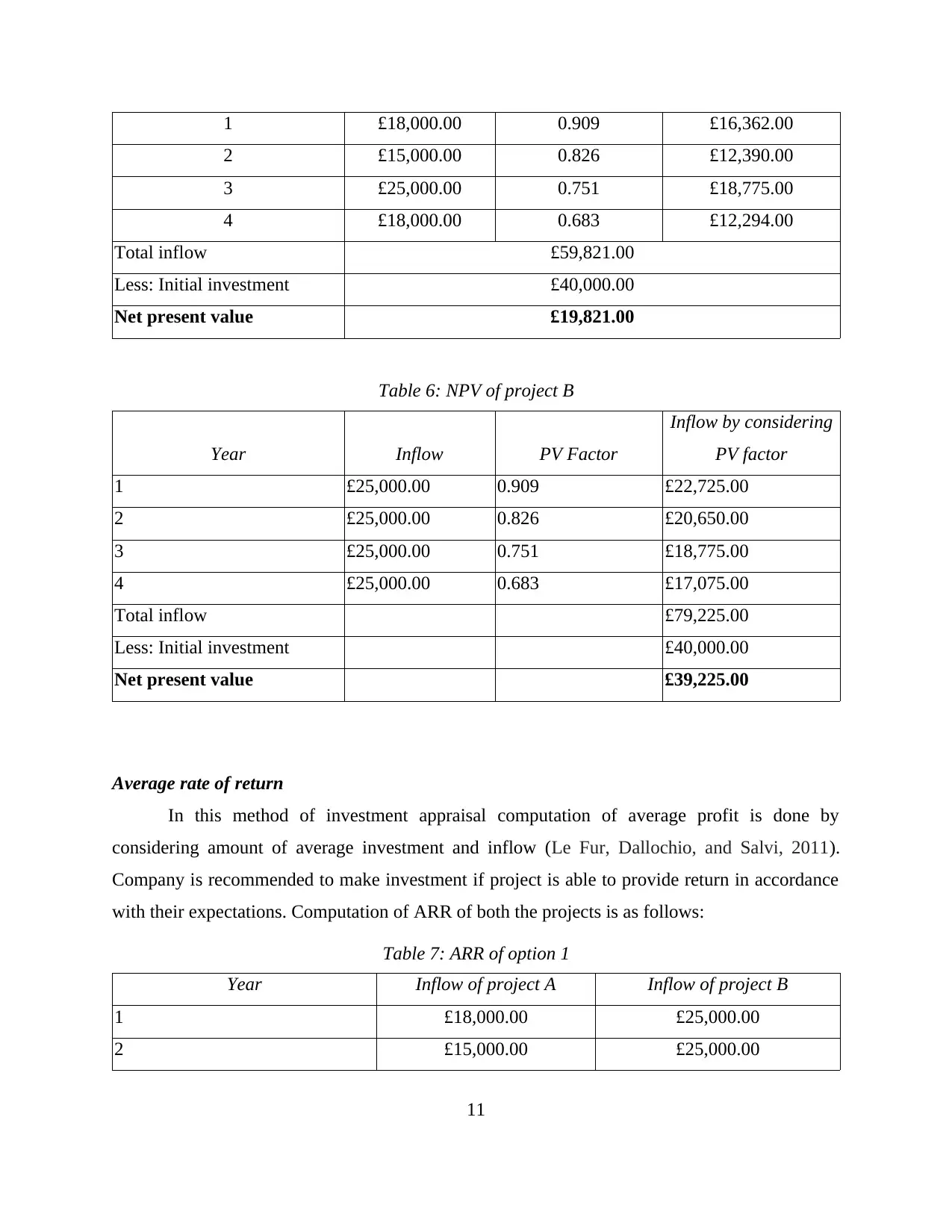
1 £18,000.00 0.909 £16,362.00
2 £15,000.00 0.826 £12,390.00
3 £25,000.00 0.751 £18,775.00
4 £18,000.00 0.683 £12,294.00
Total inflow £59,821.00
Less: Initial investment £40,000.00
Net present value £19,821.00
Table 6: NPV of project B
Year Inflow PV Factor
Inflow by considering
PV factor
1 £25,000.00 0.909 £22,725.00
2 £25,000.00 0.826 £20,650.00
3 £25,000.00 0.751 £18,775.00
4 £25,000.00 0.683 £17,075.00
Total inflow £79,225.00
Less: Initial investment £40,000.00
Net present value £39,225.00
Average rate of return
In this method of investment appraisal computation of average profit is done by
considering amount of average investment and inflow (Le Fur, Dallochio, and Salvi, 2011).
Company is recommended to make investment if project is able to provide return in accordance
with their expectations. Computation of ARR of both the projects is as follows:
Table 7: ARR of option 1
Year Inflow of project A Inflow of project B
1 £18,000.00 £25,000.00
2 £15,000.00 £25,000.00
11
2 £15,000.00 0.826 £12,390.00
3 £25,000.00 0.751 £18,775.00
4 £18,000.00 0.683 £12,294.00
Total inflow £59,821.00
Less: Initial investment £40,000.00
Net present value £19,821.00
Table 6: NPV of project B
Year Inflow PV Factor
Inflow by considering
PV factor
1 £25,000.00 0.909 £22,725.00
2 £25,000.00 0.826 £20,650.00
3 £25,000.00 0.751 £18,775.00
4 £25,000.00 0.683 £17,075.00
Total inflow £79,225.00
Less: Initial investment £40,000.00
Net present value £39,225.00
Average rate of return
In this method of investment appraisal computation of average profit is done by
considering amount of average investment and inflow (Le Fur, Dallochio, and Salvi, 2011).
Company is recommended to make investment if project is able to provide return in accordance
with their expectations. Computation of ARR of both the projects is as follows:
Table 7: ARR of option 1
Year Inflow of project A Inflow of project B
1 £18,000.00 £25,000.00
2 £15,000.00 £25,000.00
11
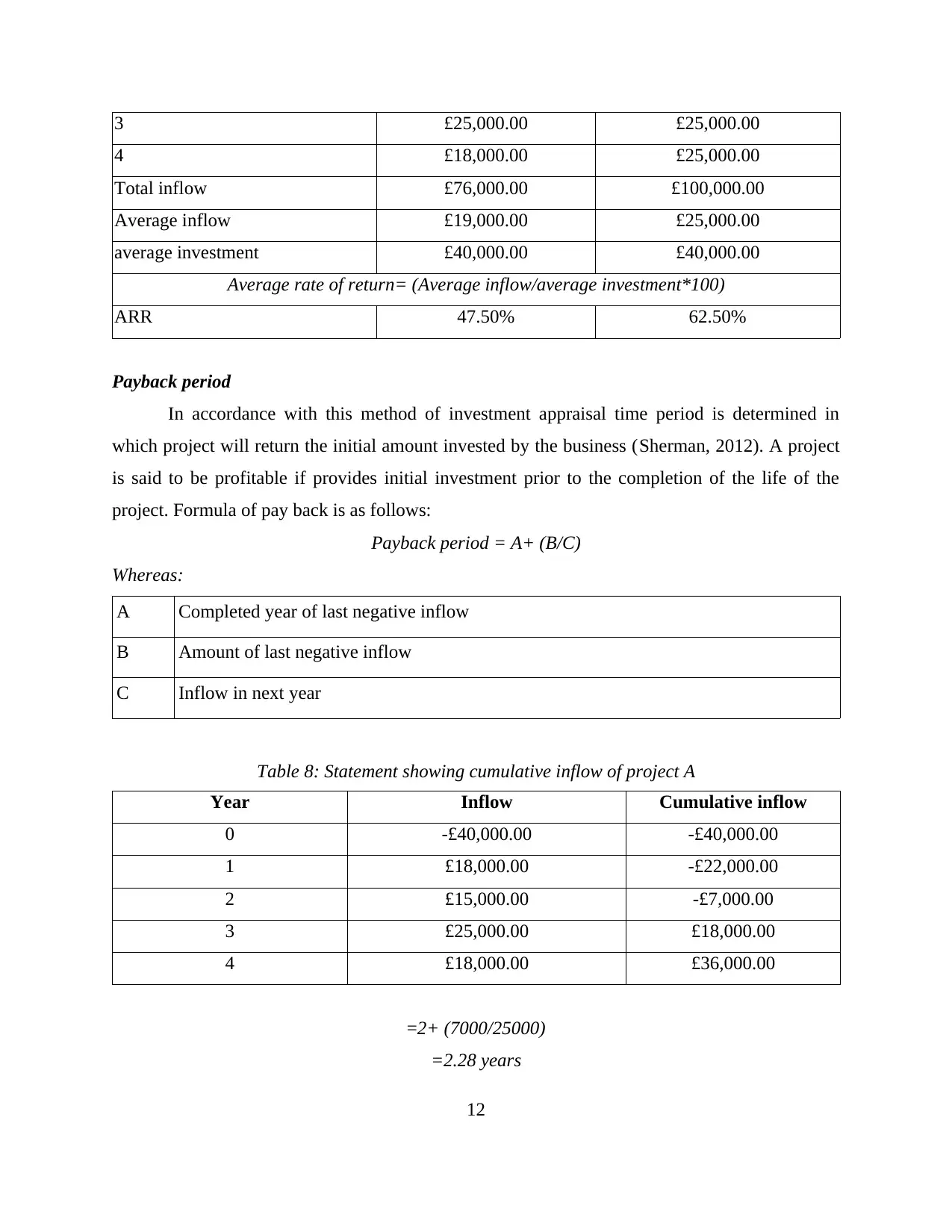
3 £25,000.00 £25,000.00
4 £18,000.00 £25,000.00
Total inflow £76,000.00 £100,000.00
Average inflow £19,000.00 £25,000.00
average investment £40,000.00 £40,000.00
Average rate of return= (Average inflow/average investment*100)
ARR 47.50% 62.50%
Payback period
In accordance with this method of investment appraisal time period is determined in
which project will return the initial amount invested by the business (Sherman, 2012). A project
is said to be profitable if provides initial investment prior to the completion of the life of the
project. Formula of pay back is as follows:
Payback period = A+ (B/C)
Whereas:
A Completed year of last negative inflow
B Amount of last negative inflow
C Inflow in next year
Table 8: Statement showing cumulative inflow of project A
Year Inflow Cumulative inflow
0 -£40,000.00 -£40,000.00
1 £18,000.00 -£22,000.00
2 £15,000.00 -£7,000.00
3 £25,000.00 £18,000.00
4 £18,000.00 £36,000.00
=2+ (7000/25000)
=2.28 years
12
4 £18,000.00 £25,000.00
Total inflow £76,000.00 £100,000.00
Average inflow £19,000.00 £25,000.00
average investment £40,000.00 £40,000.00
Average rate of return= (Average inflow/average investment*100)
ARR 47.50% 62.50%
Payback period
In accordance with this method of investment appraisal time period is determined in
which project will return the initial amount invested by the business (Sherman, 2012). A project
is said to be profitable if provides initial investment prior to the completion of the life of the
project. Formula of pay back is as follows:
Payback period = A+ (B/C)
Whereas:
A Completed year of last negative inflow
B Amount of last negative inflow
C Inflow in next year
Table 8: Statement showing cumulative inflow of project A
Year Inflow Cumulative inflow
0 -£40,000.00 -£40,000.00
1 £18,000.00 -£22,000.00
2 £15,000.00 -£7,000.00
3 £25,000.00 £18,000.00
4 £18,000.00 £36,000.00
=2+ (7000/25000)
=2.28 years
12
⊘ This is a preview!⊘
Do you want full access?
Subscribe today to unlock all pages.

Trusted by 1+ million students worldwide
1 out of 17
Related Documents
Your All-in-One AI-Powered Toolkit for Academic Success.
+13062052269
info@desklib.com
Available 24*7 on WhatsApp / Email
![[object Object]](/_next/static/media/star-bottom.7253800d.svg)
Unlock your academic potential
Copyright © 2020–2025 A2Z Services. All Rights Reserved. Developed and managed by ZUCOL.





